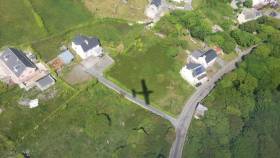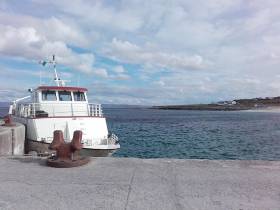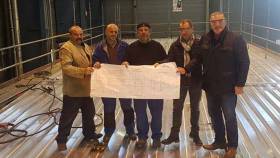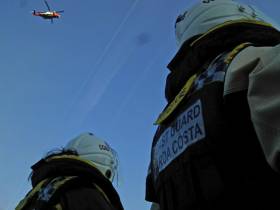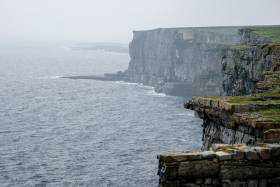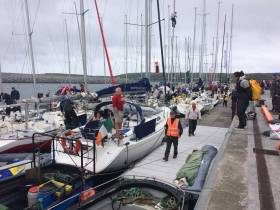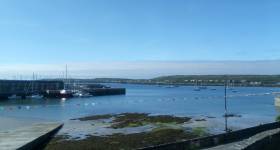Displaying items by tag: Aran Islands
Increased Turbulence Over Aran Islands Air Route
#IslandNews - "It’s like Groundhog Day"… reports RTE News as residents on the Aran Islands could be forgiven a touch of dark humour this week, after it emerged that the contract to operate daily flights to and from the mainland was being terminated.
In a dispute over the terms of its four-year contract with the Government, Aer Arann served notice that it will end the deal in early December.
It is not the first time that the air link between the islands and Conamara has been the subject of discussion. In fact, in recent years, it has almost become an annual occurrence.
Air and ferry travel to 19 islands [see related to Aran] is subsidised by the Department of Culture, Heritage and the Gaeltacht.
The Public Service Obligation (PSO) subvention is paid to different operators, to ensure there are regular crossings to and from the islands for residents.
Figures on the Department’s website show that the total PSO cost comes to over €5.95 million each year.
Given the seasonal nature of tourism to the islands, the subsidy ensures that islanders can access the mainland all year round. Or at least, that is what is intended.
For much more on the story, click here.
#AranIslands - Aer Arann Islands has given notice for termination of its PSO contract for the Aran Islands two years ahead of schedule, as RTÉ News reports.
The airline will end its flights between the islands and the Galway mainland at the end of December this year — once again throwing into doubt the future of the islands’ decades-long air service.
The current PSO contract was only signed in January last year after months of uncertainty, and should have secured flights between Inis Mór, Inis Meann and Inis Óirr until the end of 2020.
However, it is understood that the imposition of additional passenger fees for unscheduled journeys became a sticking point just weeks into the new arrangement.
Without mediation to resolve the issue, the airline says it can no longer continue the contract as it stands.
The news comes six months after the signing of a new ferry contract to guarantee daily ferry service to the islands until November 2022.
New Pier For Inis Oírr As €330K Funds Announced
#IslandNews - A new pier for Inis Oírr in the Aran Islands is now on the cards, as Galway Bay FM reports.
Minister of State Joe McHugh announced funding of €330,000 to appoint consultant engineers for the design and construction tender phase.
The news comes after it was announced earlier this month that €225,000 has been ringfenced for harbour projects throughout Co Galway.
€3m 'Cruise Ship' to Launch on Doolin–Aran Islands Crossing & Cliffs of Moher Cruises
Accessing Ireland’s most popular offshore destination, the Aran Islands, and the Cliffs of Moher by sea is to get a lot more comfortable, faster and environmentally friendly thanks to a record investment by one of the best known sea faring families on the west coast.
In what will be the biggest single private transport infrastructure investment on the Wild Atlantic Way, the Garrihy family run business, Doolin2Aran Ferries, has commissioned a state of the art, €3m new vessel that is being built by OCEA Shipbuilding in La Rochelle, France. This is the first ship to be built for the popular port of Doolin this decade, the last one being the Doolin Discovery, which was also commissioned by the Garrihy family in 2009.
Doolin2Aran Ferries is owned and operated by the Garrihy family from Doolin, who have been operating commercially on the seas around Doolin for half a century.
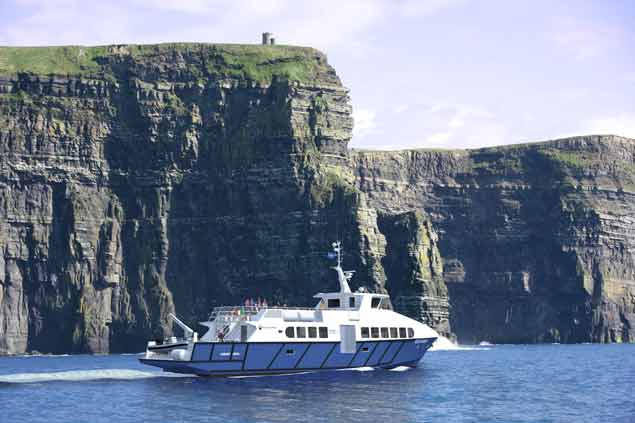 An artist’s impression of the new 26m Doolin to Aran Ferries cruise ship being built in France
An artist’s impression of the new 26m Doolin to Aran Ferries cruise ship being built in France
The 26–metre vessel will be the fastest and most comfortable domestic cruise ship on the entire Irish coast. It will operate daily sailings to the Aran Islands as well as the stunning cruise to the foot of the Cliffs of Moher, one of the West coast’s most captivating tourism experiences.
The one-off designed cruise ship will also be tailored for international tourists, with multi-lingual voice and visual guide systems to ensure visitors get the absolute experience and knowledge of the world-famous heritage sites.
In production since late October, the 200-seat vessel will have the highest specification available. It will incorporate system built seating and air conditioning, and the most advanced computerised stability system providing quality and comfort to passengers.
The ship also embraces the latest in terms of environmentally friendly technologies with a high-tech, on-board waste water treatment plant and TIER ii advanced low emission energy efficient engines.
The shipbuilders, OCEA, are one of Europe’s leading specialist manufacturers of ships for the leisure and commercial markets. Building up to 20 vessels per year, and for some of the world’s most high net-worth individuals, OCEA operates across four production sites, with 95% of its turnover garnered from the export markets. Its biggest build to date is an €80m patrol boat for a Middle Eastern client.
On completion, the Doolin2Aran Ferries vessel will be sailed back from La Rochelle, with stops in Brest in North West France before making its way to Doolin where it will join the fleet of Doolin2Aran Ferries vessels, helping to accommodate the huge increase in popularity of cruises to the islands and the Cliffs of Moher since the launch of the Wild Atlantic Way brand. It will be the largest operator sailing out of the hugely popular Aran Islands gateway pier. The Garrihy family also own and operate The Happy Hooker, The Rose of Aran, The Jack B, The Doolin Discovery and the St Bridget, which operates on Dublin Bay.
Commenting on the investment, Eugene Garrihy of Doolin2Aran Ferries said: “We worked hard to get the new improved pier facilities at Doolin and now we are investing in this state of the art vessel. We have grown the business year on year and we feel the time is right to take our business to a new level with this investment. The Wild Atlantic Way is proving a global tourism phenomenon and we have to respond in the industry by improving the quality of our offering to ever more discerning customers.
“With good visitor management and continued engagement with all tourism bodies, we are confident that the impact of this investment in the region will be very positive. The ship will be the largest and fastest operating to the islands from Doolin. As it will operate in the UNESCO Burren and Cliffs of Moher Geopark, we were also particularly conscious that it would be the most energy efficient and sustainable vessel operating here and is being custom built to that end.
“We’re really looking forward to its completion and getting it back here. There’ll be nothing like it for tourists heading out from the west coast.”
#IslandNews - A new five-year ferry contract from residents on the Aran Islands has been welcomed, as the deal will guarantee daily services to each of the three islands.
Details of the Public Service Obligation contract reports RTE News were announced by the Department of the Gaeltacht.
The contract with Aran Ferries Teo comes into effect tomorrow and will run until November 2022.
Costing almost €6 million, the agreement will see morning and evening services between Ros a' Mhíl and Inis Mór, Inis Meáin and Inis Oírr.
Bus services between Ros a' Mhíl and Galway city are also included in the contract.
As part of the deal, the price of a return fare for islanders will be capped at €10. This represents a reduction on the existing €15 fare for residents of Inis Mór.
Negotiations on the service have been ongoing for several months. For more on the story click here.
Items Found On Mayo Beach Could Belong To Missing Rescue 116 Crew
#Rescue116 - A lifejacket and helmet washed up on a beach near Blacksod in Co Mayo this weekend may belong to one of the two missing crew from the Rescue 116 tragedy earlier this year, as RTÉ News reports.
The items, which were attached together, were discovered on the shore near An Clochar yesterday morning (Saturday 30 September).
A detailed search of the area has been hampered by poor weather, with no other items found.
Winch operator Paul Ormsby and winchman Ciaran Smith have been missing since the Irish Coast Guard helicopter went down at the island of Black Rock, west of Blacksod, on 14 March.
Capt Dara Fitzpatrick was recovered at the scene but was pronounced dead in hospital shortly after. The body of Capt Mark Duffy was recovered some days later.
Elsewhere, the body of a middle-aged man was found washed up on Inis Meáin in Galway Bay last night.
RTÉ News says the discovery comes almost a fortnight to the day after a Russian national was swept into the water while sea angling near Doonbeg, some 36km south of the Aran Islands.
There was better news for the families of two fishermen feared missing in Galway Bay overnight, as the Irish Examiner reports.
Aran Islands RNLI and the Shannon-based coastguard helicopter Rescue 115 were involved in the search last night and early this morning for the pair when they were reported overdue.
But the search was called off around 10.30am when the small fishing boat, which has suffered technical issues in “challenging” conditions, returned to port under its own power.
Rescue 115 was earlier requested for a medevac from Inis Mór to University Hospital Galway.
Bidders for Ferry Service to Serve Aran Islands Sought from Department
#islandnews - Tenders for the provision of an Aran Islands-Ros a Mhil passenger ferry service are been requested from the Department of Arts, Heritage, Regional, Rural and Gaeltacht Affairs.
The contract according to Galway Bay fm would be for the period – November 1st to October 31st for ferry services from Inis Mór, Inis Oírr and Inis Meáin.
Providers who want to submit a bid must contact the Department by 2p.m on October 12th.
Earlier this year, Galway West T.D Seán Kyne, who was Minister of State at the Department of the Gaeltacht at the time, said he was committed to ensuring that Inis Mór in particular would be covered by a long term contract.
‘Tribal’ Continues To Dominate At WIORA Champs Day Two
#WIORA - With the forecast of light winds looming over the weekend, PRO Alan Crosbie opted to run three races on the second day of the Volvo WIORA Championships.
Racing started at a steady 10 knots which built to a perfect 15 knots as the day progressed. Class 1, 2 and 3 raced windward leeward courses again with the windward mark tucked in off Straw Island lighthouse out the tidal channel between Inis Mór and Inis Meáin in the Aran Islands.
In IRC 1, Liam Burke on Tribal continues to dominate the class with four straight winds ahead of Glen Cahill’s Joie de Vie in second. Lauren Heskins Dubois 33 Now What is looking comfortable in third.
In ECHO 1, Enda O’Coineen’s Kilcullen Flyer leads the way with Tribal and Joie de Vie in second and third respectively.
In IRC 2, John Callanan’s Stonehouse Racing is at the top of the pile with Aidan Breen’s Dehler 37CW in second and Smile in third. ECHO 2 sees Pat Aylwards Elixir leading from Port of Galway with IRC leaders Stonehaven in third overall.
In IRC 3, Gala Racing port tacked the whole fleet in the first race of the day going on to take the win but it’s Brian Raftery’s J24 Gossip from Sligo Yacht Club that’s leading with Gala Racing in second and Aaron O’Reilly’s Beneteau First Class 8 in third.
Gala Racing from Foynes leads ECHO 3 with Galway Bay boat Rhocstar owned by Aine Nolan in 2nd and the first class 8 in third.
The White Sails course took the fleet to a mark off Inishmann with Frankie Leonard’s Roamar leading progressive ECHO, Owen Cunningham’s Woofer in second and Simon Trezise’s Leonidas in third.
Farr 31 To The Fore At WIORA Champs Day One
Day one of the Volvo WIORA Championships dawned with a final entry of thirty nine boats and was to begin with one race and an afternoon start to facilitate crews arriving to the island of Inishmore on the morning ferries. The midday briefing was a straightforward affair with PRO Alan Crosbie, in his twelth year with the West Coast Championships.
At the briefing Jack Roy, President of Irish Sailing spoke about volunteerism and participation and gave credit to event organisers Cormac MacDonnacha and Míchéal Gill of Club Seolteoireachta Arainn for bringing the event to the island for the first time.
Not only is the scenery idyllic but the weather was also playing ball with a light southerly breeze and a windward leeward course was chosen.
In IRC 1 and ECHO 1, Liam Burke’s ‘new’ Tribal Farr 31 was to the fore with Galway Bay Sailing clubmates Glen Cahill on Joie de Vie and Now What hot on their heels after an hour and twenty minutes of racing.
In IRC 2 it was the young guns from Galway Bay Sailing Club headed up by Aideen Breen sailing Port of Galway, the Dehler 37CW owned by well-known Martin Breen. The two Corbys, Thomas Whelan of the Royal Western Yacht Club of Ireland on Stonehouse Racing& representing the Daffodil Foundation and Rob Allen on Smile filling the other spots on the podium. Ray McGibney’s Dis-A-Ray was also in the hunt finishing third in ECHO.
In IRC 3 and ECHO 3 the class is headed up by Brian Raftery’s J24 Gossip with Foynes’ J24 Gala Racing in second and the Club 8 from Galway Bay Sailing Club in third.
White Sails which has been sailed on progressive ECHO has Simon Trezise on Leonidas in first, Frankie Leonard on Roamar in second and Euphanzel III sailed by Gerry Morgan in third.
The fleet is also joined by a mini transat class with two mini’s match racing with Yannick Lemonnier to the fore.
Dusty The Dolphin Makes A Friend At Inis Oírr
#MarineWildlife - Dusty the dolphin earned a measure of infamy in previous years after attacking a number of bathers at her former home in Doolin.
But the Wild Atlantic Way’s other resident bottlenose – after Dingle's celebrated Fungie – was in a much more agreeable mood in recent days, as a new video captured by visitor Elaine Farrell shows her adorable encounter with a snorkeller at Inis Oírr.
Dusty appears perfectly calm as she rolls over in the water for a belly rub from the diver, who was perched at the stern of a boat moored in the Aran Islands harbour.
However, as cute as that encounter might be, the Irish Whale and Dolphin Group’s Dr Simon Berrow warns that Dusty and other dolphins like her are still wild animals — and getting close to them can be dangerous.
“Our advice would be: don’t swim with the dolphins,” he said, adding: “Respect their distance and don’t do anything stupid. It’s hard to know what will set off aggressive behaviour.”
Elsewhere, video from the Copeland Islands off Donagahdee show a lazy seal taking it easy on a dinghy moored off the Irish coast recently.


























